Nearly half a year after their 3D TV debut, Panasonic has produced smaller versions of their premium 50-inch 3D Plasma TV. The new, mass-market sized VT20 Plasma displays are available in 42″ and 46″ sizes, and we’ve been having a good look at the smaller of the two – the Panasonic TX-P42VT20B – over past couple of weeks.
<!-- google_ad_client = 'pub-2887677957235196'; google_ad_slot = '4990177225'; google_ad_width = 336; google_ad_height = 280; //-->
Like its larger siblings, the TX-P42VT20B features Panasonic’s best NeoPDP panel and screen coating which allows the display to produce a clean, reflection-free picture even in brighter environments. In addition, the Panasonic TX-P42VT20B boasts dual HD satellite and terrestrial tuners, ISF-vetted picture calibration controls, and comes supplied with two pairs of active shutter glasses. Also, on a minor note, the 42-inch Panasonic TX-P42VT20 and 46-inch Panasonic TX-P46VT20B differ from the earlier 50-inch version by including a 2D->3D conversion mode.
Panasonic also sent over two pairs of their newly redesigned, comfier 3D glasses with the TX-P42VT20B, so we’ll be sure to take a good look at how these differ to the first-generation models supplied with the 3DTV. On with the investigation!
Note: The specific model we tested was the Panasonic TX-P42VT20B, which is the British 3-pin-plug version. The terms Panasonic TX-P42VT20, Panasonic TXP42VT20, Panasonic TX-P42VT20B and Panasonic TXP42VT20B may be used interchangeably throughout this article to refer to the same plasma 3D TV. While we did not review the 46-inch Panasonic TX-P46VT20/ Panasonic TX-P46VT20B, there shouldn’t be any drastic differences in picture performance given nearly identical specifications.
Back when the first VT20 model (TX-P50VT20) appeared, much was made of Panasonic’s new premium Plasma HDTV being the spiritual successor to the discontinued Pioneer KURO range. Looking at the way these television displays are designed, it’s easy to see why comparisons like this were made.
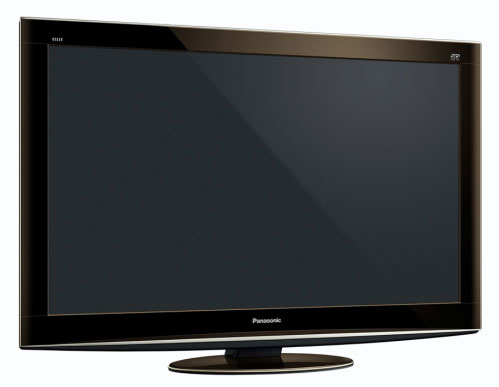
The Panasonic TX-P42VT20B feels well-built and shares a glossy, hard-edged feel, much like the Pioneer PDP-LX5090. Fortunately, the Panasonic TX-P42VT20’s design is also much less “slab” like, with rounded corners and silver trim at both the top and bottom of the unit. The tabletop stand, too, uses the familiar Panasonic “disc” shape rather than being square. The build quality is excellent as usual for Panasonic Plasmas, although the usage of gloss black (actually, gloss brown) on the TX-P42VT20B still doesn’t sit well with us due to the care it needs to keep clean.
Like all Panasonic displays from the mid-range and up, the TX-P42VT20B features 4 HDMI inputs, older analogue connectors, feeds for both the terrestrial and satellite tuners, a PC input, 2 USB ports, and a Common Interface card slot. Panasonic are fairly unique in offering a built-in satellite tuner, and this separates the connectivity of their HDTVs from most other manufacturers, who, in Europe, offer this feature either inconsistently or not at all.
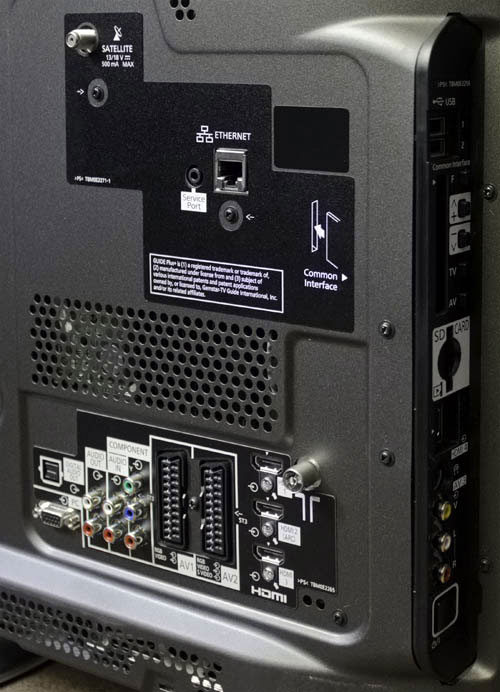 |
| Rear and Side: 4 x HDMI, VGA, component, 2 x Scarts, aerial, Freesat, ethernet, 2 x USB |
![[Picture] menu](https://www.hdtvtest.co.uk/news/wp-content/uploads/2018/04/hdtv_Panasonic-TXP42VT20B_picture.jpg) | ![[Picture] menu](https://www.hdtvtest.co.uk/news/wp-content/uploads/2018/04/hdtv_Panasonic-TXP42VT20B_picture2.jpg) |
| [Picture] menu |
We’re very familiar with the on-screen user interface in Panasonic HDTV sets now, so there’s little else to add when it comes to the TX-P42VT20. All of the controls work as expected, the menus respond quickly to user input, and they’re easy to read. User friendliness could be improved a little – for example, continental European models have numerical indicators in the on screen menus, whereas the UK versions, for some reason, still lack this. That’s really only an issue during first-time setup, though.
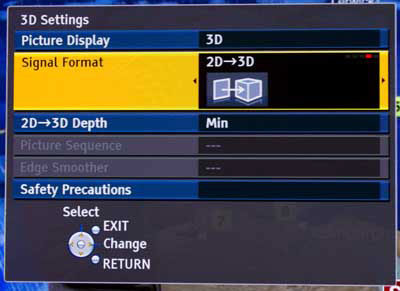 |
| 3D Menu |
Of more interest is the 3D menu on the Panasonic TX-P42VT20B, which is the same as seen on the GT20 series. Like the GT20, the Panasonic TX-P42VT20 and Panasonic TX-P46VT20 feature the 2D-to-3D conversion mode which allows content-starved 3D TV users to watch existing 2D material in “pseudo-3D”. The 3D menu also allows the user to select “Side-by-Side” or “Top-Bottom” picture formats, if the 3D content they’re viewing is encoded in this way.
Note: Our Panasonic TX-P42VT20B review sample was calibrated using Calman Professional, the industry-leading video calibration software.
After verifying that the Panasonic TX-P42VT20B had “run in” for a good number of hours, we measured the THX mode’s Greyscale tracking quality, to see how consistently and how accurately the TX-P42VT20 could reproduce grey tones. The THX mode is arguably the most important on the HDTV, since it’s designed to give the most accurate, high quality picture, without any additional calibration work. As such, this is likely to be the one that a good chunk of users end up selecting.
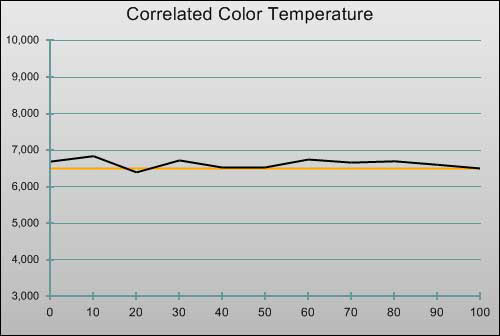 |
| Pre-calibration CCT in [THX] mode |
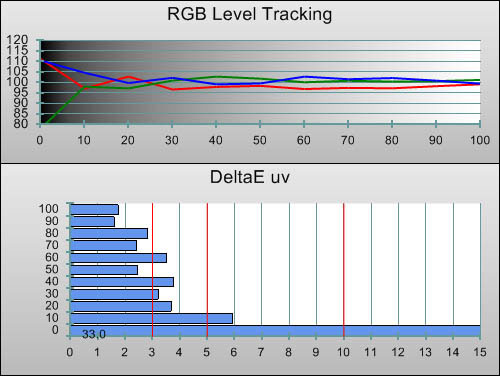 |
| Pre-calibration RGB tracking and delta errors (dEs) |
We weren’t surprised to see the Panasonic TX-P42VT20B delivering highly accurate Greyscale tracking with the THX mode selected. In fact, the accuracy here of this “one-click” preset is the best we’ve measured from a Panasonic flat-screen television recently. To the eye, images didn’t look steely and blue-tinted (like the TV’s default “Normal” mode did), nor did they look greenish and sickly (like some other HDTV’s preset modes do). The RGB Level Tracking chart reveals a couple of tiny spikes and dips, but these are so small that they’re essentially insignificant – hands up if you can pinpoint a 4% red deficiency by eye?
It’s also worth noting that the “THX” viewing mode on the Panasonic TX-P42VT20B is unique in that it has the highest light output of all three accurate picture modes (the other two being the two “Professional” modes): 100% white from the THX mode measured at around 130 cd/m2. By comparison, the Professional modes on the Panasonic TX-P42VT20B, by default, only go as high as 85 cd/m2, which may be too dark for some viewing environments. We did manage to raise the light output to nearly 100 cd/m2 by raising the [Contrast] control, although some minor clipping to bright tones was the trade-off (although these bright tones were above the range normally used for encoding video content, meaning it wasn’t really an issue).
![Post-calibration CCT in [Professional1] mode](https://www.hdtvtest.co.uk/news/wp-content/uploads/2018/04/hdtv_Panasonic-TXP42VT20B_post-cct.jpg) |
| Post-calibration CCT in [Professional1] mode |
![Post-calibration RGB Tracking in [Professional1] mode](https://www.hdtvtest.co.uk/news/wp-content/uploads/2018/04/hdtv_Panasonic-TXP42VT20B_post-rgb.jpg) |
| Post-calibration RGB tracking and dEs in [Professional1] mode |
For completeness, we also calibrated the [Professional1] viewing mode. This resulted in slightly more consistent Greyscale tracking, but the differences are so small we would struggle to pick one as being obviously better than the other (asides from the THX mode having have a slightly more visible excess of blue in darker areas). The most obvious difference between the THX mode and our calibrated [Professional1] mode was the THX mode’s higher light output.
![Gamma curve in [Professional1] mode](https://www.hdtvtest.co.uk/news/wp-content/uploads/2018/04/hdtv_Panasonic-TXP42VT20B_post-gamma.jpg) | |
| Gamma curve in [Professional1] mode | Corresponding gamma tracking |
Both Greyscale and Gamma tracking improved when we changed the [Gamma] option to 2.4 (from its default setting of 2.2). This gave us slightly more linear Gamma tracking with fewer bumps, although as with the Panasonic TX-P42GT20 we recently reviewed, we couldn’t do anything to eliminate a darker-than-ideal 90% stimulus measurement. We speculate that this is the result of some sort of undefeatable power saving mode which limits peak white, although we’d like to know for sure what’s going on. Fortunately, this wasn’t really an issue during real viewing.
Panasonic’s colour management system, although not as fully-featured as, say, Samsung’s, still manages to get the job done and allows fine-tuning of Red, Green and Blue. By extension, cleanup work done with these colours does also affect Cyan, Yellow and Magenta, although there is no direct control over these. The adjustments we made were small, because the out-of-the-box colour performance in the THX mode on our Panasonic TX-P42VT20 review unit was already very accurate.
![Post-calibration CIE chart in [Professional1] mode](https://www.hdtvtest.co.uk/news/wp-content/uploads/2018/04/hdtv_Panasonic-TXP42VT20B_post-cie.jpg) |
| Post-calibration CIE chart with reference to HD Rec.709 |
![Post-calibration Luminance levels in [Professional1] mode](https://www.hdtvtest.co.uk/news/wp-content/uploads/2018/04/hdtv_Panasonic-TXP42VT20B_post-colour-lum.jpg) |
| Post-calibration colour luminance (coloured bars = targets; black bars = measured values) |
Note: These measurements were taken with Panasonic’s new medium-sized, USB rechargable 3D glasses (TY-EW3D2ME) which we’ll discuss later in the review.
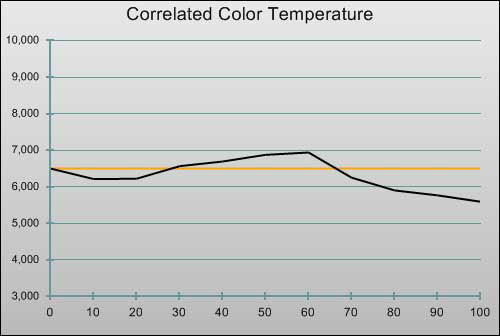 |
| 3D Pre-calibration CCT in [True Cinema] mode |
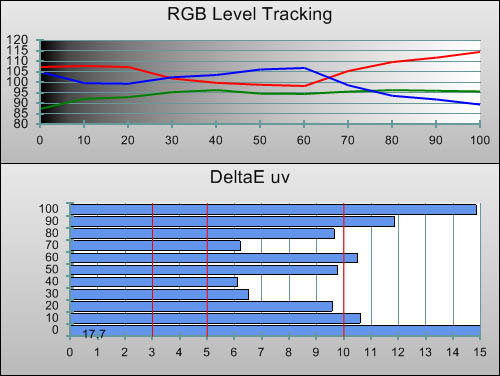 |
| 3D Pre-calibration RGB tracking and delta errors (dEs) |
After measuring the Panasonic TX-P42VT20B directly without any 3D glasses attached to our colorimeter, we confirmed that it has the same uneven Greyscale characteristics as the two other Panasonic 3D displays we’ve reviewed. We then attached the new 3D glasses in front of our Klein K-10 colorimeter’s lens, enabled 3D mode on the TX-P42VT20, and ran a pass of Greyscale tracking measurements, to get some idea of the purity and consistency that users can expect to see with their own eyes when they’re watching 3D material.
Before any further adjustments are done, the Panasonic TX-P42VT20B’s 3D images tend to have a pinky-red, “salmon-coloured” tint to them in brighter areas. This is relatively consistent with our experiences of the two other Panasonic 3D TVs we’ve reviewed, the TX-P42GT20 and the TX-P50VT20. The snowy environments in the Ice Age 3 demo clip at the start of Panasonic’s latest 3D demo disc are the most obvious manifestation of this, so it didn’t take us long to try to calibrate out the reddish tint.
![3D Post-calibration CCT in [Professional1] mode](https://www.hdtvtest.co.uk/news/wp-content/uploads/2018/04/hdtv_Panasonic-TXP42VT20B_3d-post-cct.jpg) |
| 3D Post-calibration CCT in [Professional1] mode |
![3D Post-calibration RGB Tracking in [Professional1] mode](https://www.hdtvtest.co.uk/news/wp-content/uploads/2018/04/hdtv_Panasonic-TXP42VT20B_3d-post-rgb.jpg) |
| 3D Post-calibration RGB tracking and dEs in [Professional1] mode |
As you can see, after calibration, the Greyscale tracking on the Panasonic TX-P42VT20B was different, but it was not really much more consistent: if you compare the shapes of the Red, Green and Blue lines in the Before and After charts, you’ll be able to see fairly similar curves each time. We managed to tame the pinky-red look by neutralising high-end Greyscale tracking as best we could, although we ended up with an excess of blue and a deficiency of red in the mid-tones. To our eyes, this was an overall improvement, but when tracking is this non-linear, there are probably a few ways you could adjust the controls to make an overall improvement, but never to result in perfection.
It was only last year that enthusiast users and calibrators were banging on Panasonic’s door requesting that they add Greyscale calibration controls, but if maintaining Greyscale consistency in 3D on Plasma televisions is to be this challenging, they would do well to expand the existing 2-point [White Balance] menu to a 10-point system, to allow 3D picture quality to be improved. (Samsung has included this feature for 2D display already, although their HDTVs don’t allow it to be used with 3D video).
![3D Gamma curve in [Professional1] mode](https://www.hdtvtest.co.uk/news/wp-content/uploads/2018/04/hdtv_Panasonic-TXP42VT20B_3d-post-gamma.jpg) | |
| 3D Gamma curve in [Professional1] mode | 3D Corresponding gamma tracking |
Panasonic appear to have successfully adjusted the colour reproduction of their TVs’ 3D display mode to counter-act the shutter glasses. When measuring the Panasonic TX-P42VT20B “bare” (or simply looking at colour test patterns without the glasses on), the colours of Cyan and Magenta are noticeably distorted. After slipping the glasses on, the colours are closer to the familiar Rec.709 positions. Of course, this could just be a coincidence, since 3D TV is the “wild west” when it comes to standardisation at the moment.
![3D Post-calibration CIE chart in [Professional1] mode](https://www.hdtvtest.co.uk/news/wp-content/uploads/2018/04/hdtv_Panasonic-TXP42VT20B_3d-post-cie.jpg) |
| 3D Post-calibration CIE chart with reference to HD Rec.709 |
![3D Post-calibration Luminance levels in [Professional1] mode](https://www.hdtvtest.co.uk/news/wp-content/uploads/2018/04/hdtv_Panasonic-TXP42VT20B_3d-post-colour-lum.jpg) |
| 3D Post-calibration colour luminance (coloured bars = targets; black bars = measured values) |
| Dead pixels | None |
| Screen uniformity | Perfect |
| Overscanning on HDMI | 0% with [16:9 Overscan] set to “Off“ |
| Blacker than black | Passed |
| Calibrated black level | 0.013 cd/m2 |
| Black level retention | Occasional subtle “floating blacks” |
| Primary chromaticity | Excellent |
| Scaling | Excellent |
| Video mode deinterlacing | Very effective jaggies reduction |
| Film mode deinterlacing | Failed 3:2/ 2:2 cadences in all resolutions |
| Viewing angle | Excellent (> 150°) |
| Motion resolution | 1080 |
| Digital noise reduction | [P-NR] is a spatial filter, very little effect |
| Sharpness | Defeatable edge enhancement |
| Image retention | Virtually none in 2D, some in 3D |
| Posterization | Mild, though worse with poor source |
| Phosphor trails | Yes (reduced from 2D-only models); severity depends on individual susceptibility |
| 1080p/24 capability | No judder (2D), No judder with “3D 24p Film Display” on (3D) |
| Input lag | 47ms (2D), 16ms (3D) slower than a lag-free CRT |
| Full 4:4:4 reproduction | No (2D), Yes (3D) |
| Default [THX] mode (2D) | 234 watts |
| Default [True Cinema] mode (3D) | 220 watts |
| Calibrated [Professional1] mode (2D) | 178 watts |
| Calibrated [Professional1] mode (3D) | 256 watts |
| Standby | 1 watt |
Measurements taken with full 50% grey screen.
We don’t think Panasonic produces a Plasma TV that isn’t at least “excellent” when it comes to producing black. Even the lower-end S20 series managed to produce a deep 0.02 cd/m2 black (with a fully dark screen, that is); by comparison, the Panasonic TX-P42VT20, as part of the top range, produces 0.013 cd/m2, which is nearly on par with the 0.009 cd/m2 we measured from the TX-P50VT20 and TX-P42V20. All of these HDTV displays produce satisfyingly rich blacks.
Keep in mind that when we do black level measurements, we do them at night with the room lighting turned off, giving an idea of how the HDTV will perform in a darkened home cinema environment (a best-case scenario). With ambient light hitting the panel, blacks obviously won’t be as deep, but the Panasonic TX-P42VT20B’s screen coating gives it an edge over cheaper models, and allows it to maintain a relatively high contrast image.
Now that we have a “floating blacks” revealing scene pinpointed (the last medium shot of Morgan Freeman at the end of Chapter 5 on the Se7en BD), we can confirm that the Panasonic TX-P42VT20B does feature this mildly annoying effect, but it does appear to be even milder than it was on the TX-P42GT20. The rise in brightness in the black letterbox bars above and below the picture is repeatable, but whether or not you’ll see it depends largely on your viewing environment. In a pitch black room, even a small change in brightness like this will be noticeable (and potentially irritating). In brighter rooms, it would likely go unnoticed. We’re used to seeing some brightness fluctuation from most Plasma TVs and often observe the same effect when we display a 100% windowed test pattern during Greyscale calibration, so we’re not surprised that slight inconsistencies can pop up in real world content.
Panasonic’s 2009 plasma models sadly did not age very well, and after glowing reviews, owners reported that their plasma televisions were starting to glow exactly when they shouldn’t be: the black level quality degraded quickly, meaning that tones which were once jet black soon became slightly (some would say markedly) greyer. The good news is that no degradation of the same level has so far been reported with the 2010 models, and CNET US, who performed long-term testing, reported only a tiny degradation of black level: their measurements of the US equivalent of the TX-P50VT20 revealed blacks which started at 0.01 cd/m2 and rose to 0.02 cd/m2 after 1543 hours of usage (with no other major jumps expected). Either of these are enough to produce a very deep shade of black. We do wonder if this is a standard feature for all Plasma TV displays, but the gradual change over time and the expense of measuring instruments means that it has gone unnoticed until Panasonic’s 2009 models. We’d be very curious to measure one of Pioneer’s KURO plasmas and see if there has been any rise on those HDTVs.
More cautious readers may point out that the CNET US findings may not necessarily be applicable to European models, but in our opinion, this is overly cautious: the experience of American owners last year was consistent with reports from this side of the Atlantic.
Our TX-P42VT20 review sample came with Panasonic’s new 3D Blu-ray Demo Disc, which features some 2D motion resolution test clips from the APDC (Advanced PDP Development Center – a coalition of Plasma manufacturers of which Panasonic is a member). In principle, these patterns are essentially the same as those on our trusty FPD Benchmark Software Blu-ray Disc, and indeed, both tests displayed the same results. All of the lines were clean and readable (unlike a conventional LCD, which soon turns them into a smear as the chart starts to move), but as we noted with the Panasonic TX-P42GT20, we could see a fuzzy “ghost image” of the fine details offset to one side when the pattern scrolled, meaning that although the motion is crisp and sharp, it’s not free of artefacts. To put that another way: on the Panasonic TX-P42VT20B you can see just about all of the detail from the source, but with some unwanted fuzziness as well.
We then enabled the [Intelligent Frame Creation] motion interpolation system, which replaced the fuzzy “ghost image” artefacts with motion interpolation artefacts instead, as we expected. For example, with IFC turned on, the edges of the “Panasonic” logo overlaid on the footage would warp and tear, which is entirely normal behaviour for such a system (we normally avoid using them for this reason, although still recommend their usage on LCD TVs during high-motion video content such as televised sports). We hope that Panasonic isn’t forgetting that a good number of people buying Plasma TVs are videophiles who will avoid processing like this, and hope that they aren’t neglecting how their HDTVs perform with the IFC system turned off.
The Panasonic TX-P42VT20B delivers one of the best 3D experiences that money can buy today, but the more time we spend with first-generation 3D TV displays, the more restless we get with their flaws. It’s becoming clearer that, although 3D TV obviously offers depth that 2D simply doesn’t have, it does require that the user tolerate lower overall picture quality as a trade-off – at least for now.
Asides from the loss of brightness imposed by the shutter glasses (which is a problem given that the Panasonic TX-P42VT20B already doesn’t produce huge levels of light output – at least not in its most controllable picture modes), there are panel-specific issues to consider as well. With 3D Plasma TVs (or at least with Panasonic’s – we haven’t seen any others yet), this means poorer gradation (more banding visible over smooth tones), slightly lower vertical resolution (resulting in small jaggies), and non-linear Greyscale and Gamma tracking (which harm the realistic feel of the picture in more subtle ways). There’s also the higher amount of panel-generated noise coating the picture (a much subtler issue), although the VT20 displays don’t seem to have as much of it as the GT20 does.
When we displayed our custom-made 3D Resolution Test Pattern on the Panasonic TX-P42VT20, we witnessed the exact same flicker in fine areas and strobing in the Horizontal Lines area as on the TX-P42GT20. This indicates that the Panasonic TX-P42VT20B does not display the full 1080 lines of the source when it’s running in 3D mode. We were expecting the Panasonic TX-P42VT20 to be free of this issue, since we don’t remember seeing the effects of this resolution limitation on the TX-P50VT20. However, the 50VT20 was the first 3D TV we ever reviewed, so there was no basis for comparison and also no resolution test card. Maybe we’ll ask for some input from TX-P50VT20 owners to see if they notice the same jaggies on their displays?
Update (November 24, 2010): we’ve re-examined a Panasonic TX-P50VT20, and sure enough, the 50-inch TX-P50VT20B does NOT have the 3D resolution limitation, and produces a slightly cleaner picture which is free of any flickering or jaggies.
3D TV has a way to go before it matches the overall quality of 2D TV – and that’s sad, because the last most celebrated advancement in TV technology (HDTV) was all about quality. But at the same time, the new experiences 3D brings can’t be ignored outright. Just try watching one of the 3D setpieces from a film like Monsters Vs Aliens (are you getting tired of hearing about that one yet?) but flattened into 2D. Although the image quality is undeniably better, it is a considerably different and less exciting experience.
After we’d calibrated 3D Greyscale as best we could on the Panasonic TX-P42VT20B, we had a look at the 3D clips from Panasonic’s new sampler disc, and jumped back and forth between the pre- and post-calibrated settings. As mentioned, the Ice Age 3 clip displayed reddish snow prior to calibration, and a more natural look afterwards. The clips from Avatar featured on the disc were also impressive.
Interestingly, Panasonic have posted a list of picture settings which they recommend using with the imminent Avatar 3D Blu-ray Disc on their global web site. These have been selected by James Cameron himself, using the 65″ (if memory serves) Plasma monitor at Panasonic’s Hollywood Blu-ray authoring facility as a reference. We’re not sure how this will translate to the consumer units, but presumably Panasonic has factored any differences into their recommendations. Perhaps this is overly cynical, but we wonder if this means Panasonic are aware that the out-of-the-box 3D picture quality is some way off optimal.
We tried the settings on our Panasonic TX-P42VT20 sample unit using the clips of Avatar on Panasonic’s new sample disc. The overall Colour Temperature was more reddish, and the colours appeared very saturated (presumably in an attempt to meet the Digital Cinema colour space). The image was pleasing enough, but the entire exercise highlights a very real problem with 3D today: a lack of standardisation. From this, it seems safe to assume that the 3D Blu-ray Disc of Avatar is being mastered to Panasonic’s own colour standards. Are we seriously going to end up with a situation where each 3D Blu-ray Disc comes with a sheet of settings that have to be keyed in to the 3D TV, in order for us to see the film as intended? This early “lawlessness” is eerily similar to the situation that turned the American NTSC colour system into a joke (“Never Twice the Same Colour”), and although Panasonic’s heart is in the right place by attempting to display the film as the director intended, there needs to be industry-wide agreement on just what the colour points are, so we can avoid headaches later down the line.
Speaking of which, we hear THX have a 3D Certification process going on… hopefully Panasonic’s next 3D displays can be passed through this verification process so all TV manufacturers and filmmakers can sing from the same sheet.
The 3D demo disc features a “New Eyewear” promotional clip, in which a woman walks into a store filled with swanky designer shades (cunning!), and ultimately selects Panasonic’s 3D glasses. Panasonic sent us two variants of the redesigned glasses, in both Medium (TY-EW3D2ME) and Large (TY-EW3D2LE) sizes. Smaller pairs are also available to buy. They are a complete, hands-down improvement on the original design, which put too much weight on the viewer’s nose, and weren’t too comfortable over extended periods of time.
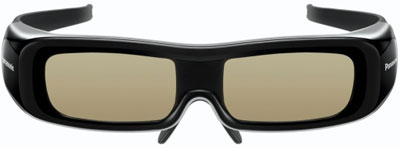
Not only do the revised Panasonic 3D glasses look better and feel more comfortable, they also now boast a built-in rechargable battery, promising some 30 hours of life (from a 2-hour charge). Yes, the days of unscrewing the 3D glasses and inserting a new watch-type battery are gone, and not a moment too soon. All the user has to do once the charge is depleted is connect the 3D glasses to a USB port, using the supplied cable. Consider the number of electronic items featuring USB ports these days (the TX-P42VT20B HDTV has two of them), and you soon get an idea of how convenient this is.
Additionally, the On/Off mechanism is now a simple switch, rather than a button. This means users can now easily see whether the glasses are turned on correctly.
Remember, the above only applies to Panasonic’s new 3D glasses. The Panasonic TX-P42VT20 is supplied with two sets of the old ones, which, as noted above, are not as convenient or comfortable. It’s a shame that additional expenditure is required for the improved models, but most TV manufacturers don’t include any bundled 3D glasses at all.
The TX-P42VT20B features the same SD video processing quality as every other 2010 Panasonic Plasma televisions. There are only so many times we can re-word this, so allow us to re-hash a quick summary:
The last point plays strongly in the Panasonic TX-P42VT20’s favour, and once combined with the accurate Greyscale tracking, colour performance, and high contrast Plasma look, makes for some very satisfying standard definition viewing.
We watched the brand new transfers of Alien and Aliens from the newly released Blu-ray Disc box set, and once again, 2D HD proved to be the best experience from the review process. The visuals displayed by the Panasonic TX-P42VT20B with these discs as a source was outstanding in just about every way. The Panasonic TX-P42VT20 reproduced these excellent film scans (Aliens in particular has an almost unfathomable amount of detail present) without any unwanted edge enhancement or other revisionism.

If you’re paying close attention, you’ll notice that the Plasma panel’s own dithering (which is unavoidable given how Plasma displays operate) does interact with and change the look of the grain slightly. We did also once notice a very small amount of coloured fringing visible (the beginning of Chapter 10 of the second film), but this was a very minor observation given the wonderfully deep blacks and accurate colours on show. We strongly feel that the Panasonic TX-P42VT20 is delivering one of the best television-sized presentations of movie material, and that the only obvious way to improve upon this today is to buy a suitably high quality projector, projection screen, and room treatments.
The Panasonic TX-P42VT20B’s video processor adds a delay of 47ms between user input and actual video display, regardless of whether the HDTV is in its “Game” or “Professional” picture modes. This is an alarmingly high amount of input lag from a brand that has traditionally produced very fast screens. (When comparing this figure to those reported elsewhere on the web, please remember that this measurement is taken against an entirely lag-free CRT monitor, making it a direct comparison).
For players of fast-paced first person shooters, it’s pretty disappointing. Up until now, Panasonic’s Plasma TVs have consistently excelled at being gaming screens, lagging by only about 20ms or so (we measured a lighting-quick 16ms on one model). The only way to bring back these joyful levels of responsiveness on the Panasonic TX-P42VT20B is, bizarrely, to engage the 2D-to-3D conversion mode. As on the Panasonic TX-P42GT20 (which lagged by 30ms), enabling 3D drive mode cuts input lag back down to just 16ms in spite of the extra depth conversion. Normally, we wouldn’t have gone out of or way to measure this mode, but the performance difference is not subtle in the slightest. With just 16ms of lag, moving the viewpoint in first person shooter games is quick and responsive, whereas with 47ms of latency, it feels more like you’re fighting with the controller to make movements which should be smooth and effortless. Unfortunately, because 3D mode on current-generation 3D TVs means overall lower picture quality, and because 2D-to-3D conversion is not really worthwhile, this means that there is no optimal way of playing 2D games (in 2D) on the Panasonic TX-P42VT20.
To reiterate: we measured the same 47ms figure in both the Professional and Game picture modes. In other words, the “Game” picture mode does not actually cut down processing. This has always been the case on Panasonic’s Plasma displays, but in the past, all picture modes delivered speedy input-to-screen performance, so this didn’t matter. Now that input lag is becoming an issue, Panasonic should really produce a more useful “Game” option which cuts out as much processing as possible.
Recently, we have had some user feedback from Panasonic TX-P50VT20 owners (one of whom had bought the display based on our May 2010 review which specifically recommended it for gaming). They told us that their own units do not perform as well with games as ours did, and that the 3D mode cuts input lag down considerably. This is consistent with our own experiences of both the Panasonic TX-P42GT20 and now the TX-P42VT20, and does suggest the certain TX-P50VT20s perform differently to the (store-bought) unit we reviewed. Perhaps units manufactured after a certain date will have the same issue with input lag?
In the past, when I first played games on Panasonic’s Plasma televisions, I had the feeling that it was almost too good to be true: high contrast, no motion blur, and no input lag worth worrying about. It’s a shame that the party, for now, appears to be over: gaming still looks excellent, but it doesn’t feel excellent. We hope Panasonic will remedy this either with firmware updates, or at least on upcoming models.
The Panasonic TX-P42VT20B, the smallest model in Panasonic’s VT20 range, is not quite the equal of the excellent TX-P50VT20 that we reviewed in May. Although the picture quality is essentially just as good, 47ms of input lag is an unfortunate dent which harms this HDTV’s ability to be recommended (almost) unconditionally for any home entertainment purpose. And certainly, the smaller screen diminishes the impact of 3D material, but this is perhaps something of a moot point on a review of a 42″ display.
If you’re not a gamer (or if you only tend to play slower paced genres where the input lag is more tolerable), this won’t really matter to you. Like the rest of the Panasonic Plasma lineup, the 2D image quality on the TX-P42VT20 is absolutely excellent with only a little bit of panel-generated noise in particularly frantic motion areas to consider as a down-side. The 3D quality, whilst still in its early stages, is amongst the best we’ve seen on the market today (although this is perhaps as much to do with a lack of serious contenders as much as it is with the quality of the product).
The best going price at the time of writing is around £1500, making this an expensive 42-inch HDTV display. However, this is the price of new technology, and the fact that the Panasonic TX-P42VT20B also includes two pairs of 3D glasses (albeit the older, less comfy ones) and produces some of the best 2D images on the market should cushion the financial blow.

<!-- google_ad_client = 'pub-2887677957235196'; google_ad_slot = '0693194791'; google_ad_width = 336; google_ad_height = 280; //-->